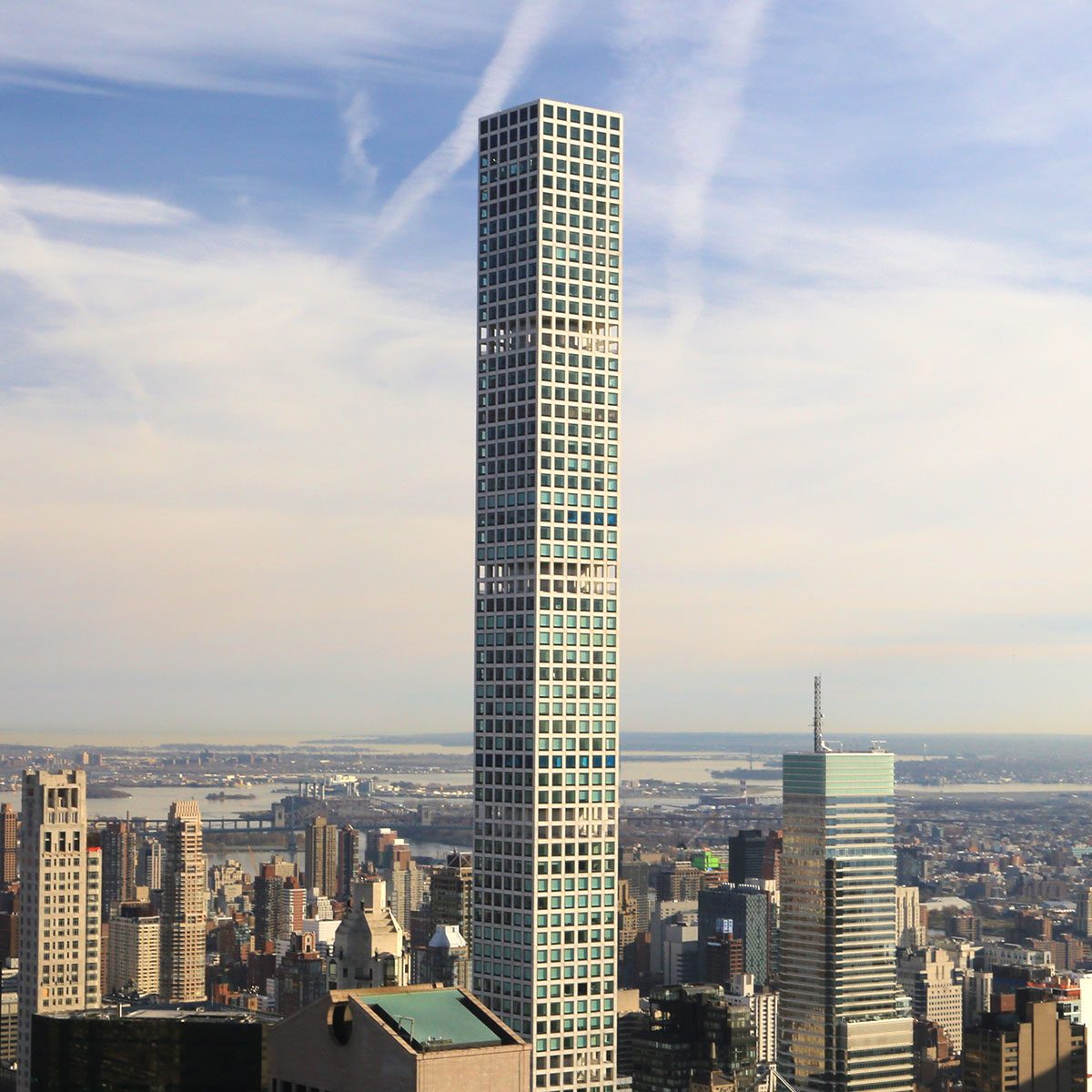Is it haunted or just well-ventilated?

Here’s Why Skyscrapers Don’t Have 13th Floors

You hop in a skyscraper elevator, glance at the floor buttons and—oh, hold on. There’s 12 … and 14. Where’s 13? Is it hidden behind a secret panel? Do the rich people have it all to themselves? Is it full of cursed office printers (all office printers are cursed in my experience) and haunted coffee machines?
The answer to this mystery isn’t quite a supernatural thriller, but it does have something to do with ancient fears, modern marketing gimmicks and a touch of real-estate law, says Glenn Nowak, a member of the American Institute of Architects and a professor of architecture at the University of Nevada, Las Vegas. “There are many cultural superstitions surrounding different numbers, and these absolutely affect the way buildings are built and designed, both in the U.S. and around the world,” he explains. “A big part of architecture is understanding the psychology of how people think.”
So what’s going on, exactly? We got to the bottom of people’s charming little neuroses and uncovered all sorts of fascinating facts about those mysterious 13th floors. Read on and you’ll be floored by the truth. (Pun absolutely intended.)
Get Reader’s Digest’s Read Up newsletter for more interesting superstitions, humor, travel, tech and fun facts all week long.
Why don’t tall buildings have 13th floors?
The short answer? People are weird about the number 13. Like, really weird. It’s considered unlucky, so we avoid it in hotel rooms, lottery tickets and dinner parties. (Twelve guests is elegant. Thirteen? That’s how you accidentally summon a demon during dessert.)
So when skyscrapers first started being constructed in the late 19th century, building owners made a choice: Why risk scaring off superstitious tenants when you can just skip 13 altogether? And this isn’t just urban legend. According to Otis Elevators—the literal authority on going up and down floors, which has been around since 1853—most buildings with elevators omit the 13th floor entirely. (Fun fact: The chief archivist of Otis, who shared that tidbit on Instagram, was born on a Friday the 13th. You can’t make this stuff up.)
The fear of the number 13 even has a name: triskaidekaphobia—a word that sounds like black magic but is really more of a marketing problem. It’s why people get jumpy on Friday the 13th, won’t pick 13 on a lottery ticket and definitely don’t want to sign a lease on the 13th floor.
“This superstition has become so widespread in Western culture that no one wants to be working or living on a 13th floor,” says Nowak. Because if anything goes wrong—power outage, creepy hallway, copier jam—guess what gets blamed? That spooky, unholy prime number.
When did this tradition start?
Rumor has it the superstition started with the very first skyscraper: the Home Insurance Building in Chicago, completed in 1885. While we can’t verify if it actually skipped the 13th floor (many original blueprints have been lost or eaten by history), whispers persist that this original high-rise quietly tiptoed over the number like a kid avoiding cracks in the sidewalk.
This wasn’t true for other early architectural giants. For instance, the Flatiron Building in New York City (1902) does have a 13th floor, as do the Woolworth Building (1913), the Chrysler Building (1930) and the Empire State Building (1931). So maybe the superstition hadn’t fully kicked in yet. Or maybe those architects were just braver. Or worse at counting.
But somewhere along the way, the fear of the 13th floor gained traction—superstition did increase during the 1930s, in general—and developers started snipping 13 right out of the blueprints.
Why is 13 so unlucky?

If you’re wondering why the number 13 gets such a bad rap, blame Judas. According to Nowak, the superstition dates all the way back to the Last Supper, where the 13th guest at the table ended up betraying Jesus. And the number 13 has been ruining dinner parties ever since.
But Christianity didn’t invent unlucky dinner parties. In Norse mythology, 12 gods were having a feast in Valhalla when Loki crashed as the 13th guest. Chaos broke out, and Balder, the god of joy, was killed. So basically, 13 has been ruining group dinners for centuries.
There’s also numerology, which absolutely has opinions. Twelve is considered a “perfect” number: 12 months, 12 zodiac signs, 12 doughnuts in a box (important). So 13? It ruins the perfection.
All this superstition got baked into our culture like a weirdly haunted casserole. Hotels, airlines and especially skyscrapers started skipping the number altogether. Why risk it? If something weird happens on the 13th floor, everyone immediately blames the floor (instead of, say, Chad from IT, who clicked on the suspicious email titled “Get Rich in 13 Seconds!” and made the whole network go down).
Are skyscrapers still being built without 13th floors?
Yes … sometimes. Even in today’s skyscrapers—with smart elevators, biometric security and toilet seats that could probably file your taxes—developers are still wary of the number 13. Why? Because people are still wary of the number 13.
“It’s not always that simple, though,” says Nowak. “These days, all building designs have to meet national and local code regulations, and many places have rules about whether or not you can skip floor numbers.” This is for safety reasons. Imagine firefighters responding to an emergency and discovering that Floor 14 is actually Floor 13 in disguise. That kind of confusion could be dangerous—or even fatal.
But if the building codes do allow it, the decision is up to the owner and the architect. And yes, sometimes they’ll choose to leave out the 13th floor, Nowak says, especially in hotels, where guests come and go constantly, bringing with them every superstition in the book (and probably a few they made up on the plane). “It’s most common in Las Vegas buildings,” he adds, “because games of chance go hand in hand with superstition.”
And here’s a twist: Sometimes the absence of a 13th floor has nothing to do with ancient curses or ghost stories. In high-rise buildings, it’s common to include a “mechanical floor” every 10 to 12 stories to house things like HVAC systems. “So you may see the 13th floor labeled as ‘M’ for Mechanical,” Nowak explains. “Sometimes it just works out neatly like that.”
But isn’t the 14th floor really the 13th?
“Every time someone asks me why buildings don’t have a 13th floor, I laugh and tell them, ‘Well, they do have a 13th floor—even if it’s not labeled as such,'” Nowak says.
So, yes. Mathematically. Absolutely. No matter how you label it, it’s still the 13th floor, going from the ground up. But if the pretense helps people work and sleep better, the deception is fine, he says. It’s a little like calling your spinach smoothie “Green Monster” so your toddler will drink it. Because at the end of the day, the missing 13th floor isn’t about logic. It’s about comfort. It’s about tradition. And it’s about not having to explain to tenants why their microwave exploded at exactly 13:13 on Friday the 13th. Coincidence? Of course … probably.
RELATED:
- If Your House Was Built in the ’50s or ’60s, You Might Have This Unique Feature in Your Bathroom
- Here’s Why Some Retailers Are Called Big-Box Stores (Hint: It’s Not What You Think)
- Here’s Why Soda Cans Are Beveled on the Bottom
About the experts
|
Why trust us
At Reader’s Digest, we’re committed to producing high-quality content by writers with expertise and experience in their field in consultation with relevant, qualified experts. We rely on reputable primary sources, including government and professional organizations and academic institutions as well as our writers’ personal experiences where appropriate. We verify all facts and data, back them with credible sourcing and revisit them over time to ensure they remain accurate and up to date. Read more about our team, our contributors and our editorial policies.
Sources:
- Glenn NP Nowak, architect and professor of architecture at the University of Nevada, Las Vegas; phone interview, June 10, 2025
- WSRB: “The Mystery of the Missing 13th Floor”
- Instagram: “Otis Elevators”























